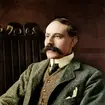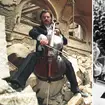What’s the history of Elgar’s Cello Concerto – the work with a disastrous premiere?
10 December 2024, 17:08 | Updated: 10 December 2024, 17:15

Elgar's Cello Concerto - Sterling Elliott | Classic FM
The story behind Elgar’s famous Cello Concerto is as dramatic as the music itself.
Listen to this article
Arguably the most instantly recognisable and dramatic pieces of music ever written for the instrument, Elgar’s Cello Concerto is one of the greatest pieces of music written in the early 20th century.
The work opens with a deep cry of despair from the cello, that sets the scene for a journey through dark and light, a world apart from the ‘Pomp and Circumstance’ Marches that were highly familiar to audiences in the 1910s.
Read more: These are factually the 15 best cello pieces in existence

What caused Elgar to change his style so dramatically for this concerto?
The English composer completed his stormy and expressive concerto in 1919, in the aftermath of the devastation caused by the First World War. By this time, Elgar’s music – which was deeply connected to the Edwardian period – had begun to fall out of fashion and the composer was experiencing a profound identity crisis.
The numerous episodes of depression Elgar experienced were not fully appreciated in the era of the ‘Stiff Upper Lip’. After finishing The Music Makers in 1912, he reported feeling “empty and cold”, writing: “How I hated having written anything; so I wandered out again & shivered & longed to destroy the work of my hands – all wasted”.
Elgar’s natural predisposition to self-doubt, combined with his struggle to feel relevant and the despair felt nationwide in the post-war years, clearly had a huge effect on the composer’s outlook in the lead-up to composing his Cello Concerto.
Read more: 10 of Elgar’s greatest pieces of music
In 1918 Elgar underwent an operation in London to have a tonsil removed. Upon his return home, he penned the melody that would transform into the opening theme, played as a whisper by the viola section.
Around this time, he and his wife retired to their country cottage ‘Brinkwells’ near Fittleworth, Sussex. The three chamber works Elgar composed in 1918 were all notably darker in colour and style, deviating from his previous works. After they received their first performances the Spring of 1919, Elgar turned his attention to the Cello Concerto, after being reminded by his friend, the cellist Carl Fuchs, of an early promise to write the work.
All the context surrounding the genesis of the concerto resulted in a much moodier, more reflective and mournful piece of music from the composer, famous for his ‘lighter’ pieces of music, such as ‘Salut d’amour’ and ‘Chanson du matin’.
The work starts with a deep cry from the cello, which gives way to the main theme – an introspective whisper of a melody played by the viola section. The cello then takes the listener on a journey of great emotion, supported by the orchestra.

The disastrous premiere
Unfortunately the premiere of Elgar’s Cello Concerto, which happened on 27 October 1919, was a complete disaster. The concert was led on the podium by the conductor Albert Coates, apart from the concerto, which Elgar decided he wanted to conduct. Coates overran his rehearsal time which meant there was very little time for the musicians of the London Symphony Orchestra to fully grasp the new work.
As Lady Elgar wrote, “That brutal selfish ill-mannered bounder ... that brute Coates went on rehearsing.”
As a result of this, the LSO was in such poor form that it prompted Ernest Newman, a contemporary critic, to remark that “never, in all probability, has so great an orchestra made so lamentable an exhibition of itself”. Yikes!

The disastrous performance did not help Elgar’s already fragile mood, and the concerto was not performed again for more than a year, in stark contrast to his First Symphony, which received hundreds of performances worldwide. Elgar praised the preparation of Felix Salmond, remarking that had it not been for his effort, he would have withdrawn the work permanently.
It was not until the 1960s that the concerto achieved the fame it deserved when the legendary cellist Jacqueline du Pré recorded and performed the piece extensively, notably with Sir John Barbirolli and the LSO in 1965. Since then, it has been universally recognised as one of the greatest concertos of all time.
























